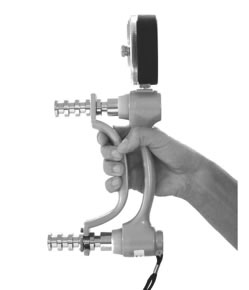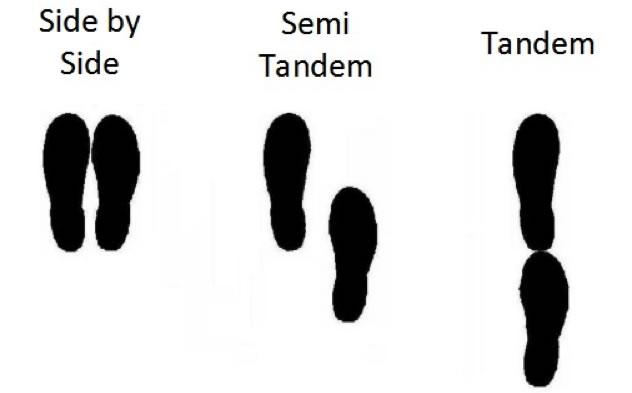Liver Frailty Index® Instructions
Grip Strength
- Set the adjustable handle to the standard position – second ring from the inside.
- Have the patient use their dominant hand to grip the dynamometer. The patient should have a neutral shoulder and forearm, elbow at 90°, and not rest the device on anything during the test.
- Please squeeze with your maximum strength and hold steadily for a few seconds.
- Record the highest force exerted to the nearest kg. The red peak-hold needle will automatically remain at the highest force exerted.
- Repeat this test three times. Reset the peak-hold needle to zero after each attempt.

Chair Stands
- I would now like you to try to move your body in different movements. I will first describe and show each movement to you. Then I’d like you to try to do it. If you cannot do a particular movement, or if you feel it would be unsafe to try to do it, tell me and we’ll move on to the next one. Let me emphasize that I do not want you to try to do any exercise that you feel might be unsafe.
- Do you think it would be safe for you to try to stand up from a chair five times without using your arms?
- Have the patient sit in a chair with their feet touching the floor and arms crossed in front of their chest.
- Instruct the patient that they must do five chair stands as fast as they can. Please demonstrate to the patient.
- For each chair stand, the patient must stand up fully from the chair (with knees straight) and then sit down again as quickly as possible.
- Please stand up straight as QUICKLY as you can five times, without stopping in between. After standing up each time, sit down and then stand up again. Keep your arms folded across your chest. I’ll be timing you with a stopwatch.
- When the patient is properly seated, say: "Ready? Stand" and begin timing.
- Count out loud as the participant arises each time, up to five times.
- Stop if patient becomes tired or short of breath during repeated chair stands.
- Stop the stopwatch when he/she has straightened up completely for the fifth time.
- Also stop:
- If the patient uses his/her arms
- After 1 minute, if patient has not completed rises
- At your discretion, if concerned for patient’s safety
- If the patient stops and appears to be fatigued before completing the five stands, confirm this by asking "Can you continue?"
- If the participant says "Yes," continue timing. If participant says "No," stop and reset the stopwatch.
- If the patient completed all 5 chair stands within 60 seconds, record the total time in seconds to one decimal place.
- If the patient did not complete all 5 chair stands in 60 seconds, enter 0 for the time.
Balance
- Balance is tested in 3 positions – side-by-side, semi-tandem, and tandem (see picture below)-for 10 seconds each.
- The tester may help the patient to get into the proper position, but they must hold the poses on their own without the assistance of a person, or a cane, walker, etc.
- The patient can move their body during the testing to maintain balance but must keep their feet in the proper position.
- If the patient cannot hold a pose for the full 10 seconds, allow them a second attempt. If still unable, record the time they held the pose in seconds to one decimal place.
Side-by-Side
- Demonstrate the side-by-side balance position.
- I want you to try to stand with your feet together, side-by-side, for about 10 seconds.
- You may use your arms, bend your knees, or move your body to maintain your balance, but try not to move your feet. Try to hold this position until I tell you to stop.
- Stand next to the patient to help him/her into the side-by-side position.
- Supply just enough support to the patient’s arm to prevent loss of balance.
- When the patient has his/her feet together, ask "Are you ready?"
- Then let go and begin timing as you say, "Ready, begin."
- Stop the stopwatch and say "Stop" after 10 seconds or when the patient steps out of position or grabs your arm.
- If the patient held the position for 10 seconds, record 10 seconds.
- If the patient could not hold the position for 10 seconds, record the time to one decimal point.
Semi-Tandem
- Demonstrate the semi-tandem balance position.
- Now I want you to try to stand with the side of the heel of one foot touching the big toe of the other foot for about 10 seconds. You may put either foot in front, whichever is more comfortable for you.
- You may use your arms, bend your knees, or move your body to maintain your balance, but try not to move your feet. Try to hold this position until I tell you to stop.
- Stand next to the patient to help him/her into the semi-tandem position.
- Supply just enough support to the patient’s arm to prevent loss of balance.
- When the patient has his/her feet together, ask "Ready, begin."
- Stop the stopwatch and say "Stop" after 10 seconds or when the patient steps out of position or grabs your arm.
- If the patient held the position for 10 seconds, record 10 seconds.
- If the patient could not hold the position for 10 seconds, record the time to one decimal point.
Tandem
- Demonstrate the tandem balance position.
- Now I want you to try to stand with the heel of one foot in front of and touching the toes of the other foot for about 10 seconds. You may put either foot in front, whichever is more comfortable for you.
- You may use your arms, bend your knees, or move your body to maintain your balance, but try not to move your feet. Try to hold this position until I tell you to stop.
- Stand next to the patient to help him/her into the tandem position.
- Supply just enough support to the patient’s arm to prevent loss of balance.
- When the patient has his/her feet together, ask "Ready, begin."
- Stop the stopwatch and say "Stop" after 10 seconds or when the patient steps out of position or grabs your arm.
- If the patient held the position for 10 seconds, record 10 seconds.
- If the patient could not hold the position for 10 seconds, record the time to one decimal point.


